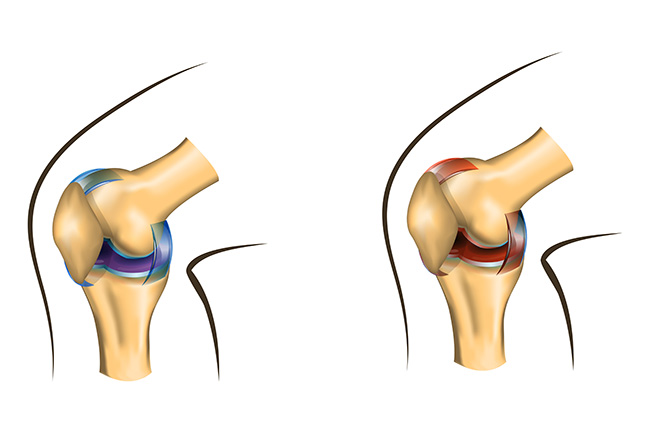Joint Replacement
Joint Replacement
Shoulder
Among the three ball-and-socket joints of our body, the shoulder has the widest range of motion. Unlike the other joints, there is a mismatch between the ball and socket of the shoulder, akin to a golf ball on a tee. When the cartilage that lines the surfaces of the bones begins to thin and degenerate, there is bone-on-bone wear of the joint. This leads to pain and limited range of motion, a condition known as arthritis. We offer a wide range of shoulder replacement procedures for the most common sources of arthritis. These include shoulder resurfacing, partial shoulder replacement, total shoulder replacement and reverse shoulder replacement.
Hemi-resurfacing
Shoulder arthritis in a young patient and avascular necrosis of the shoulder are two common indications for a hemi-resurfacing surgery. In this operation, the “ball” part of the shoulder is smoothed and a metal cap is fitted onto its surface. This removes the bone on bone rubbing that occurs in the arthritic ball-and-socket shoulder joint.
Hemiarthroplasty
Shoulder hemiarthroplasty can be a very successful operation in a young patient with significant isolated degeneration of the humeral head, or the “ball” part of the shoulder joint. Commonly called a Partial Shoulder Replacement, in this operation a small amount of bone from the ball of the shoulder is removed and replaced with a metal ball and a short metal stem. The “socket” portion of your joint remains as is.
Total Shoulder Arthroplasty
When both the ball and the socket portions of the joint are affected by bone-on-bone arthritis, both these surfaces are replaced. The humerus is fitted with a metal ball and a short stem, and the glenoid or the socket is fitted with a specialized plastic. This is what is known as a complete shoulder replacement.
Reverse Total Shoulder Arthroplasty
If one has bone-on-bone arthritis of the shoulder, while also having a large rotator cuff tear that is either chronic or un-repairable, a Reverse Shoulder Replacement is the ideal option. In this procedure, the ball and socket portions of your shoulder are flipped, thus relying on the deltoid muscle for subsequent motion.

Knee
Arthritis of the knee affects millions of people around the world. There are several reasons for this, the most principle of which is the fact that this joint is a weight-bearing joint. Non-operative treatment of knee arthritis comprises of medications like acetaminophen, other anti-inflammatory medications, physical therapy and cortisone or “gel-like” knee injections. When pain and dysfunction persists despite these measures, a Knee Replacement or a Total Knee Arthroplasty is an excellent surgical option. In this procedure, a metal cap is placed over the joint surfaces with a specialized plastic in between. Post-operative rehab is of paramount importance for successful outcomes. The knee joint is the most commonly replaced joint throughout the world and has proved to be a superb treatment option for knee pain due to bone-on-bone arthritis.

© 2024 Anchor Bone and Joint. All Rights Reserved.

